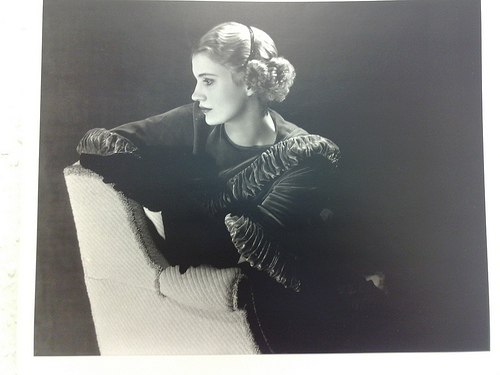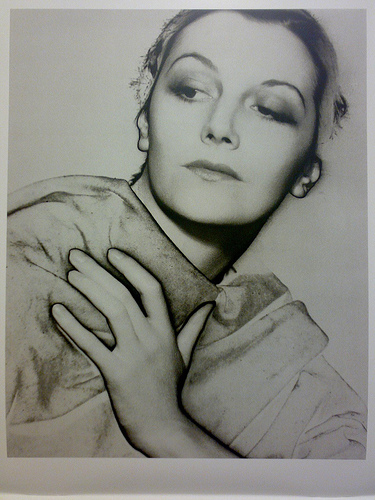Telling the story of my Finding Ada heroine for 2010 – photographer Lee Miller – requires taking a broad perspective. Her life’s achievement is a composite of a number of key strands: art, photography, fashion, technology and war reporting, bound together by a pioneering spirit.
This hurried blog isn’t the place to explore and understand these all in detail. Lee Miller was a breakthrough figure for a number of reasons – this is just a snapshot.
Born in Poughkeepsie, New York state in 1907, Elizabeth “Lee” Miller left for Paris at the age of eighteen where, according to Ursula Butler:
“She studied lighting, costume and theatre design at Ladislas Medgyes’s School of Stagecraft. She later returned to New York and enrolled in the Art Students League. There she met Condé Nast and he introduced Miller to the world of modeling. From 1926-1929 she modeled, but eventually wanted to see what life was like behind the camera. Miller studied under the great dada-surrealist artist and photographer Man Ray. Under his supervision, Miller learned how to manipulate the photograph to make a self-contained, semi-abstract or dreamlike image.”
She also became his wife and established her own studio. So far so interesting, but things were just hotting up.
The word ‘photography’ was coined by scientist Sir John F.W. Herschel in 1839 (though it had been coined seperately by Hercules Florence in 1834!) and is actually is derived from two Greek words: ‘photos’ meaning light and ‘graphein’ meaning draw. The pace of technology development in cameras and photography accelerated during the early twentieth centry, but our subject’s contribution to the science of photography was a marriage of chance and artistry. Miller brought the alchemy.
Much debate surrounds the issue as to which of the couple stumbled across a technique in photography that – like a reverse negative of the ‘photography’ coinage – had been discovered a few times previously but not clearly defined and adopted: namely solarisation.
“The effect was usually caused by inadvertent severe over-exposure or occasionally by accidentally exposing an exposed plate or film to light before processing. Artist Man Ray perfected the technique which was accidentally discovered in his darkroom by his assistant Lee Miller.” [Wikpedia]
Whatever the facts, Man Ray was soon flying the flag for perfecting this technique whilst his collaborator Miller was merely, again, known as his model (although she marshalled the technique to equally compelling effect – see her above ‘Portrait of an Unknown Woman’ from 1930). Man Ray was of the controlling variety, and Miller being a woman of substance soon broke free of his grip. She continued to be deeply involved in the Surrealist movement, amassing a body of work in her late twenties and early thirties that puts her on a par with the leading figures in photographic art and photo journalism, though this has only been recognised in the last two decades after her death, thanks to the meticulous recovery, ordering and promotion of her archives by her son.
A friend of Picasso – and combining commercial fashion photography and artistic work while entwined in a bohemian milieu – what beguiles me is the mastery she achieved in the realm of photography by bringing with her all her selves as she worked though each chapter of her career and each dimension of her work. There was truth and artifice – with neither undermining the other – in her iconic photo ‘Women with fire masks’ (1941), taken on the street of her own residence in Hampstead.
Conversely, when Vogue sent her off with a Rolliflex to Europe to cover the end of the war and the liberation, her photos combined a self-sufficient, often mysterious power with a visceral sense of unfolding drama. As she travelled through a bombed-out, shattered Europe, her camera captured many of the most powerful images of the closing months of that dark chapter in the last century. From the Italian front and the first ever use of Napalm at the siege of St Malo, to the death camps of Buchenwald and Dachau, and the liberation of Paris, you can view a wide selection of her potent war images online in the Lee Miller Archive.
Mistress of the lens, at the height of her career she lived for several years in this house on Downshire Hill in Hampstead, also spending time in Egypt and travelling widely, before moving to Farley Farm House in east Sussex. She had two further marriages, the second to British surrealist artist Roland Penrose whom she stayed with.
After the war, whilst still doing the occasional fashion shoot, Miller’s overall profile declined and she suffered bouts of clinical depression alleged (in retrospect) to have been symptoms of post-traumatic stress disorder caused by the horrors she had seen while on war assignment. In turn, her ironic sensibility was reinforced with disillusionment at the limited type of commercial work she was being offered. Women en masse had successfully taken on all sorts of previously “male” roles during the conflict, and as a surrealist photojournalist embedded with the US army Miller was among them. But after the war, governments scrambled to promote traditional values in their efforts to glue broken societies back together, and opportunities for women in the working world shrank.
In her lifetime, she was all to aware of the cultural – and personal – impact of womens’ abilities and output being marginalised. A photograph she composed of Max Ernst and his partner, artist Dorothea Tanning, encapsulates her subversive take on this.
The recognition she has posthumously achieved was acknowledged on a grand scale some 30 years after her death in a major retrospective at the V&A in 2007, which I attended, plus coverage and exhibitions globally in the last decade. Now the scales have been duly re-balanced, we can celebrate Miller as a true icon and pioneer in the art and technology of photography. For innovation and inspiration personified, look to Lee Miller on Ada Lovelace Day.
—
Ada Lovelace Day is an annual worldwide day of blogging to celebrate the achievement of women in science and technology. More information on Ada Lovelace Day 2010 can be found on the Finding Ada website. This post hasn’t been much about technology per se – it’s what we do with it that matters…






